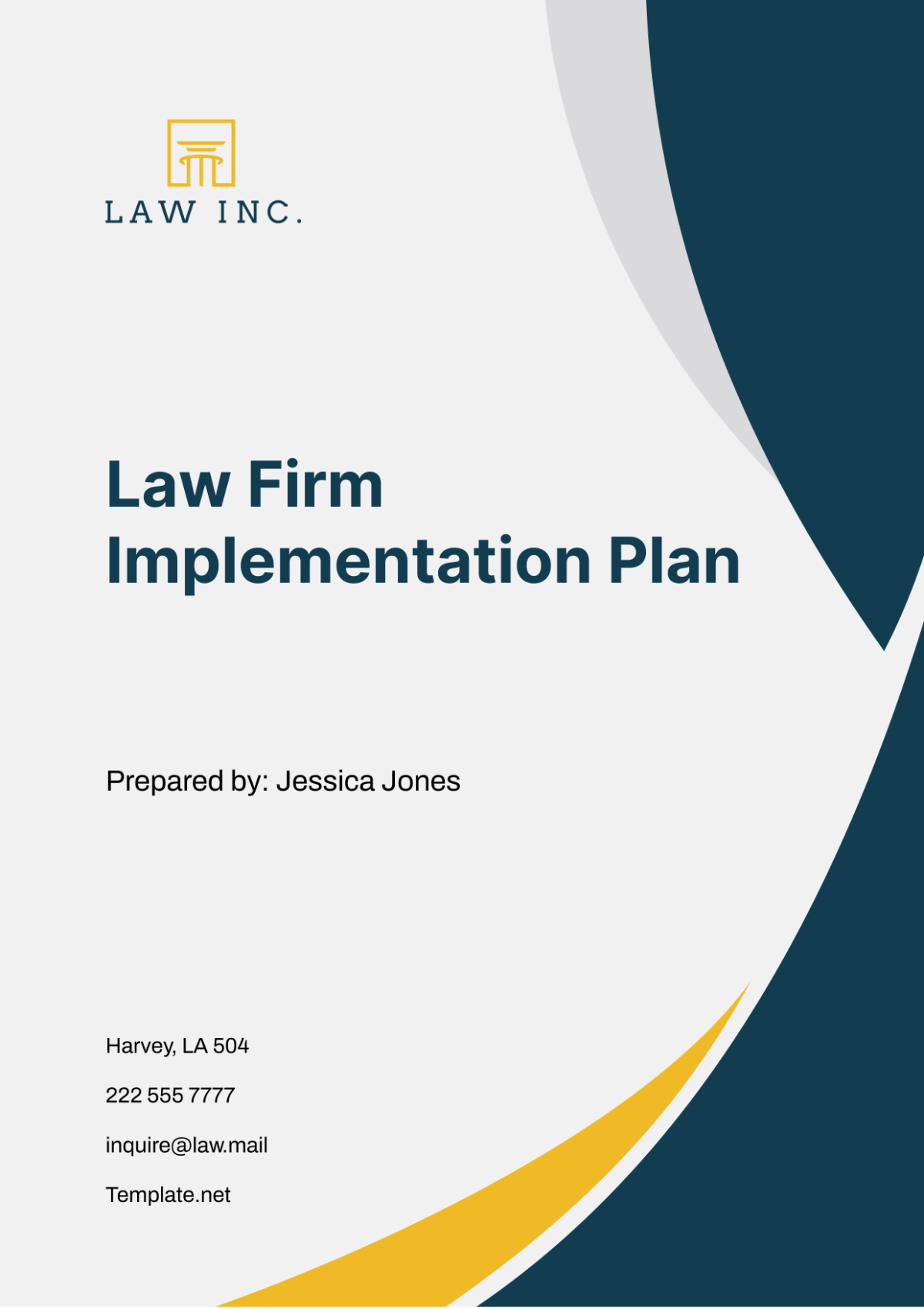Law Firm Implementation Plan
I. Executive Summary
The Implementation Plan outlines the strategic initiatives and action steps necessary to execute key objectives within [Your Company Name]. By providing a structured roadmap for implementation, this plan aims to drive efficiency, enhance effectiveness, and achieve desired outcomes in alignment with the firm's strategic goals.
II. Objectives
Operational Excellence: Streamline internal processes and workflows to optimize efficiency and resource utilization.
Client Satisfaction: Enhance the client experience through improved communication, responsiveness, and service delivery.
Market Expansion: Explore opportunities to expand into new practice areas or geographical regions to meet evolving client needs and market demands.
Talent Development: Invest in staff training and development to foster a culture of continuous learning, growth, and excellence.
III. Implementation Strategy
The Implementation Strategy is structured into four distinct phases aimed at ensuring a systematic and effective execution of key objectives within [Your Company Name].
A. Assessment Phase:
Stakeholder Engagement: Engage with clients, staff, and management through surveys, interviews, and feedback sessions to gather insights and perspectives on current operations, systems, and client needs.
Data Analysis: Analyze feedback, client data, and operational metrics to identify trends, patterns, and areas for improvement, informing strategic priorities and decision-making.
Strategic Prioritization: Prioritize identified areas for improvement based on their alignment with firm objectives, potential impact, and feasibility of implementation.
B. Planning Phase:
Objective Setting: Define clear and measurable objectives for each strategic initiative, ensuring alignment with the firm's mission, vision, and values.
Action Planning: Develop detailed action plans outlining specific tasks, responsibilities, timelines, and milestones for each initiative, ensuring clarity, accountability, and alignment with strategic priorities.
Resource Allocation: Allocate necessary resources, including personnel, technology, and budget, to support the successful execution of identified initiatives, optimizing resource utilization and minimizing risks.
Risk Assessment: Identify potential risks and develop mitigation strategies to address challenges that may arise during the implementation process, ensuring proactive risk management and contingency planning.
C. Execution Phase:
Initiative Implementation: Execute identified initiatives according to the established action plans and timelines, coordinating efforts across departments and teams to drive progress and achieve objectives.
Monitoring and Tracking: Monitor progress and track performance against predefined metrics and key performance indicators (KPIs), regularly reviewing status updates and adjusting course as needed to ensure alignment with objectives.
Communication and Collaboration: Foster open communication and collaboration among staff members, stakeholders, and external partners, ensuring transparency, accountability, and shared ownership of initiatives.
Training and Support: Provide training and support to staff members to ensure they are equipped to adopt new processes, systems, and technologies effectively, fostering a culture of learning and development.
D. Evaluation Phase:
Performance Review: Conduct regular reviews and evaluations to assess the effectiveness and impact of implemented initiatives against predefined metrics and KPIs.
Feedback Solicitation: Solicit feedback from clients, staff, and stakeholders to gauge satisfaction levels, identify areas for improvement, and inform future strategic planning and decision-making.
Continuous Improvement: Foster a culture of continuous improvement, learning, and adaptation, leveraging insights gained from evaluations and feedback to refine processes, enhance performance, and drive ongoing success.
IV. Key Initiatives
Operational Excellence:
Streamline administrative processes, such as billing, invoicing, and document management, to improve efficiency and accuracy.
Implement technology solutions, such as case management software and communication platforms, to automate routine tasks and enhance collaboration.
Client Satisfaction:
Enhance communication channels to provide clients with timely updates, information, and access to legal resources.
Implement client feedback mechanisms, such as satisfaction surveys and feedback forms, to gather input and continuously improve service delivery.
Market Expansion:
Conduct market research to identify emerging trends, opportunities, and potential areas for expansion or diversification.
Develop targeted marketing and business development strategies to penetrate new markets and attract clients in identified practice areas or geographical regions.
Talent Development:
Provide ongoing training and professional development opportunities for staff members to enhance their skills, knowledge, and competencies.
Foster a culture of mentorship, collaboration, and innovation to empower staff to excel in their roles and contribute to the firm's success.
V. Timeline
This timeline provides a structured overview of the phases, activities, and corresponding timelines for the Implementation Plan within [Your Company Name] Law Firm, facilitating effective planning, execution, and evaluation of strategic initiatives.
Phase | Activities | Timeline |
|---|---|---|
Assessment Phase | Stakeholder Engagement | Month 1 |
Data Analysis | Months 1-2 | |
Strategic Prioritization | Month 2 | |
Planning Phase | Objective Setting | Month 3 |
Action Planning | Months 3-4 | |
Resource Allocation | Month 4 | |
Risk Assessment | Months 4-5 | |
Execution Phase | Initiative Implementation | Months 5-7 |
Monitoring and Tracking | Ongoing | |
Communication and Collaboration | Ongoing | |
Training and Support | Ongoing | |
Evaluation Phase | Performance Review | Months 8-9 |
Feedback Solicitation | Month 9 | |
Continuous Improvement | Ongoing |
VI. Resources
The successful implementation of strategic initiatives within [Your Company Name] Law Firm requires the effective allocation and utilization of various resources across different phases of the implementation process. These resources encompass personnel, technology, financial investments, and supportive infrastructure to ensure the seamless execution of key objectives.
A. Personnel Resources:
Leadership Team: Provide strategic guidance, direction, and oversight to ensure alignment with firm objectives and priorities.
Project Managers: Coordinate and manage the execution of strategic initiatives, ensuring adherence to timelines, budgets, and quality standards.
Cross-Functional Teams: Engage diverse teams representing different practice areas and departments to contribute their expertise, insights, and efforts toward achieving common goals.
Subject Matter Experts: Leverage specialized knowledge and skills from individuals with expertise in specific areas relevant to identified initiatives, ensuring informed decision-making and effective execution.
B. Technology Resources:
Software Solutions: Implement and leverage technology solutions such as case management software, communication platforms, and analytics tools to streamline processes, enhance collaboration, and facilitate data-driven decision-making.
Infrastructure: Ensure access to robust IT infrastructure, including hardware, networks, and cloud services, to support the scalability, reliability, and security of technology platforms and systems.
Training and Support: Provide training and support to staff members to ensure they are proficient in using technology tools and platforms effectively, fostering adoption and maximizing ROI on technology investments.
C. Financial Resources:
Budget Allocation: Allocate financial resources to support the implementation of strategic initiatives, including personnel costs, technology investments, training programs, and other operational expenses.
Capital Investment: Invest in infrastructure upgrades, technology enhancements, and other capital expenditures to modernize operations, improve efficiency, and enhance competitiveness in the market.
Contingency Funds: Set aside contingency funds to address unforeseen challenges, risks, or opportunities that may arise during the implementation process, ensuring financial resilience and flexibility to adapt to changing circumstances.
D. Supportive Infrastructure:
Administrative Support: Utilize administrative staff to provide logistical support, coordinate meetings, manage documentation, and handle other administrative tasks to facilitate the smooth execution of strategic initiatives.
Communication Channels: Establish effective communication channels and platforms to facilitate collaboration, information sharing, and decision-making among staff members, stakeholders, and external partners.
Feedback Mechanisms: Implement feedback mechanisms, such as surveys, focus groups, and suggestion boxes, to solicit input from clients, staff, and stakeholders, enabling continuous improvement and alignment with evolving needs and expectations.
VII. Risk Management
A. Operational Risks:
Risk: Operational inefficiencies, resource constraints, or procedural bottlenecks may impede the smooth execution of strategic initiatives, leading to delays, cost overruns, or suboptimal outcomes.
Mitigation Strategies:
Conduct a thorough assessment of existing operations and workflows to identify potential inefficiencies or bottlenecks.
Implement process improvements, automation solutions, or resource reallocation strategies to streamline operations and enhance efficiency.
Monitor progress and performance against predefined metrics and benchmarks, identifying early warning signs of operational challenges and addressing them proactively.
B. Technology Risks:
Risk: Technical issues, system failures, or cybersecurity threats may disrupt the functionality or integrity of technology platforms and tools critical to the implementation process.
Mitigation Strategies:
Implement robust cybersecurity measures, including encryption, firewalls, and access controls, to protect sensitive data and mitigate the risk of data breaches or cyberattacks.
Regularly update and maintain technology infrastructure and software applications to address vulnerabilities and ensure optimal performance and reliability.
Provide training and support to staff members to enhance their cybersecurity awareness and best practices, reducing the risk of human error or negligence leading to security incidents.
C. Financial Risks:
Risk: Budget overruns, unexpected expenses, or revenue shortfalls may strain financial resources and jeopardize the successful completion of strategic initiatives.
Mitigation Strategies:
Develop a comprehensive budget that accurately reflects the costs associated with implementing strategic initiatives, including personnel, technology, and operational expenses.
Monitor expenditures and financial performance closely, identifying variances or deviations from the budget and taking corrective action as needed to ensure fiscal discipline and alignment with financial goals.
Establish contingency funds or reserve allocations to address unforeseen expenses or revenue fluctuations, providing a buffer against financial risks and uncertainties.
D. Reputational Risks:
Risk: Negative publicity, client dissatisfaction, or stakeholder disapproval resulting from missteps, errors, or failures during the implementation process may damage the firm's reputation and credibility.
Mitigation Strategies:
Maintain open and transparent communication with clients, stakeholders, and the public, providing regular updates on progress, challenges, and successes throughout the implementation process.
Address client concerns or complaints promptly and professionally, demonstrating a commitment to resolving issues and maintaining client satisfaction.
Proactively manage stakeholder expectations and perceptions by setting realistic goals, communicating clearly about potential risks, and delivering on promises consistently.
E. Legal and Regulatory Risks:
Risk: Non-compliance with legal or regulatory requirements, changes in legislation, or legal disputes may expose the firm to legal liabilities, fines, or reputational damage.
Mitigation Strategies:
Stay informed about relevant laws, regulations, and industry standards applicable to the firm's operations and strategic initiatives, ensuring compliance and minimizing legal risks.
Establish internal policies, procedures, and controls to ensure adherence to legal and regulatory requirements, with regular reviews and updates to reflect changes in the legal landscape.
Seek legal advice or guidance as needed to address complex legal issues or mitigate potential liabilities, leveraging expertise from internal or external legal counsel to navigate legal challenges effectively.
VIII. Conclusion
The Implementation Plan provides a structured framework for executing strategic initiatives within [Your Company Name], driving operational excellence, enhancing client satisfaction, expanding market presence, and fostering talent development. By adhering to the outlined strategy and leveraging available resources effectively, the firm can achieve its objectives and position itself for long-term success in a competitive legal landscape.





























